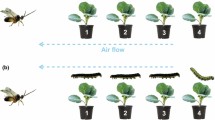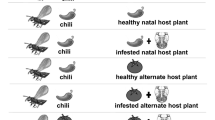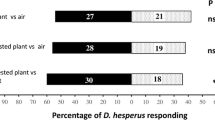Abstract
The effect of experience on the responsiveness of the braconid parasitoidAphidius ervi to host(Acyrthosiphon pisum)-associated cues was investigated on bean plants(Vicia faba) using a wind tunnel bioassay. Oviposition experience on the plant-host complex significantly increased the oriented flight and landing responses ofA. ervi females to an undamaged plant and to a plant-host(A. pisum) complex. However, oviposition experience onA. pisum aphids when isolated from the plant did not change their responses to the intact plant and the complex. Searching on an unwashed plant which had been previously damaged byA. pisum also increased their response to an undamaged plant and a host-damaged plant, whereas the experience of searching on an undamaged plant did not significantly change their responses to undamaged plants. However, when parasitoids were allowed to search on an undamaged plant which had been sprayed withA. pisum honeydew, this significantly increased their response to an undamaged plant. Oviposition experience on the plant-host complex and foraging experience on a host-damaged plant or an undamaged plant sprayed with honeydew also significantly reduced the mean time taken by the parasitoids to respond in the wind tunnel. The behavioral changes associated with such experience were acquired within 30 min and persisted for at least 3 days. The results demonstrate the capacity ofA. ervi to learn associatively olfactory cues from plants, host-damaged plants, and plant-host complexes and confirm the role of aphid honeydew as a host recognition kairomone forA. ervi.
Similar content being viewed by others
References
Bouchard, Y., and Cloutier, C. (1984) Honeydew as a source of host-searching kairomones for the aphid parasitoidAphidius nigripes (Hymenoptera: Aphidiidae).Can. J. Zool. 62: 1513–1520.
Budenberg, W. J. (1990). Honeydew as a contact kairomone for aphid parasitoids.Entomol. Exp. Appl. 55: 139–147.
Budenberg, W. J., Powell, W., and Clark, S. J. (1992). The influence of aphids and honeydew on the leaving rate of searching aphid parasitoids from wheat plants.Entomol. Exp. Appl. 63: 259–264.
De Jong, R., and Kaiser, L. (1991). Odor learning byLeptopilina boulardi, a specialist parasitoid (Hymenoptera: Eucoilidae).J. Insect Behav. 4: 743–750.
Dicke, M., van Beek, T. A., and Posthumus, M. A. (1990). Plant strategies of manipulating predator-prey interactions through allelochemicals: Prospects for application in pest control.J. Chem. Ecol. 16: 381–396.
Du, Y., Poppy, G. M., and Powell, W. (1996). Relative importance of semiochemicals from first and second trophic level in host foraging behaviour ofAphidius ervi.J. Chem. Ecol. 22: 1591–1606.
Genstat 5 Committee (1993).Genstat 5 Release 3 Reference Manual, Clarendon Press, Oxford.
Godfray, H. C. J., and Waage, J. K. (1988). Learning in parasitic wasps.Nature 331: 211.
Grasswitz, T. R., and Paine, T. D. (1993a). Effect of experience on in-flight orientation to host-associated cues in the generalist parasitoidLysiphlebus testaceipes.Entomol. Exp. Appl. 68: 219–229.
Grasswitz, T. R. and Paine, T. D. (1993b). Influence of physiological state and experience on the responsiveness ofLysiphlebus testaceipes (Cresson) (Hymenoptera: Aphidiidae) to aphid honeydew and to host plants.J. Insect Behav. 6: 511–528.
Guerrieri, E., Pennacchio, F., and Tremblay, E. (1993). Flight behavior of the aphid parasitoidAphidius ervi (Hymenopetra: Braconidae) in response to plant and host volatiles.Eur. J. Entomol. 90: 415–421.
Hagvar, E. B., and Hofsvang, T. (1989). Effect of honeydew and hosts on plant colonization by the aphid parasitoid.Ephedrus cerasicola. Entomophaga 34: 495–501.
Kester, K. M., and Barbosa, P. (1991). Postemergence learning in the insect parasitoidCotesia congregata (Say) (Hymenoptera: Braconidae).J. Insect Behav. 4: 727–747.
Kester, K. M., and Barbosa, P. (1992). Effects of postemergence experience on searching and landing responses of the insect parasitoid.Cotesia congregata (Say) (Hymenoptera: Braconidae), to plants.J. Insect Behav. 5: 301–320.
Lewis, W. J., and Martin, W. R., Jr. (1990). Semiochemicals for use with parasitoids: status and future.J. Chem. Ecol. 16: 3067–3089.
Lewis, W. J., and Takasu, K. (1990). Use of learned odours by a parasitic wasp in accordance with host and food needs.Nature 348: 635–636.
Lewis, W. J., and Tumlinson, J. H. (1988). Host detection by chemically mediated associative learning in a parasitic wasp.Nature 331: 257–259.
McAuslane, H. J., Vinson, S. B., and Williams, H. J. (1991). Influence of adult experience on host mico-habitat location by the generalist parasitoid,Campoletis sonorensis.J. Insect Behav. 4: 101–113.
Papaj, D. R., and Vet, L. E. M. (1990). Odor learning and foraging success in the parasitoidLeptopilina heterotoma.J. Chem. Ecol. 16: 3137–3150.
Pennacchio, F. (1989). The Italian species of the genusAphidius Nees (Hymenoptera, Braconidae, Aphidiinae).Boll. Lab. Ent. Agr. Filippo Silvestri 46: 75–106.
Petitt, F. L., Turlings, T. C. J., and Wolf, S. P. (1992). Adult experience modifies attraction of the leafminer parasitoidOpius dissitus (Hymenoptera: Braconidae) to volatile semiochemicals.J. Insect Behav. 5: 623–634.
Poolman Simons, M. T. T., Suverkropp, B. P., Vet, L. E. M., and de Moed, G. (1992). Comparison of learning in related generalist and specialist eucoilid parasitoids.Entomol. Exp. Appl. 64: 117–124.
Sheehan, W., and Shelton, A. M. (1989). The role of experience in plant foraging by the aphid parasitoidDiaeretiella rapae (Hymenoptera: Aphidiidae).J. Insect Behav. 2: 743–759.
Stary, P., and Delfino, M. A. (1986). Parasitoids (Hym., Aphidiidae) of aphids (Hom., Aphididae) in Tucumán, Argentina.Boll. Lab. Ent. Agr. Filippo Silvestri 43: 41–50.
Tumlinson, J. H., Turlings, T. C. J., and Lewis, W. J. (1992). The semiochemical complexes that mediate insect parasitoid foraging.Agr. Zool. Rev. 5: 221–252.
Turlings, T. C. J., Tumlinson, J. H., Lewis, W. J., and Vet, L. E. M. (1989). Beneficial arthropod behavior mediated by airborne semiochemicals. VII. Learning of host-related odors induced by a brief contact experience with host by-products inCotesia marginiventris (Cresson), a generalist larval parasitoid.J. Insect Behav. 2: 217–225.
Turlings, T. C. J., Tumlinson, J. H., Eller, F. J., and Lewis, W. J. (1990a). Exploitation of herbivore-induced plant odors by host seeking parasitic wasps.Science 250: 1251–1253.
Turlings, T. C. J., Scheepmaker, J. W. A., Vet, L. E. M., Tumlinson, J. H., and Lewis, W. J. (1990b). How contact foraging experiences affect preferences for host-related odors in the larval parasitoidCotesia marginiventris (Cresson) (Hymenoptera: Braconidae).J. Chem. Ecol. 16: 1577–1589.
Turlings, T. C. J., Waeckers, F. L., Vet, L. E. M., Lewis, W. J., and Tumlinson, J. H. (1993). Learning of host finding cues by hymenopterous parasitoids. In Papaj, D. R., and Lewis, A. C. (eds.),Insect Learning, Chapman & Hall, London, pp. 51–78.
Vet, L. E. M. (1988). The influence of learning on habitat location and acceptance by parasitoids.Colloq. Inst. Natl. Rech. Agron. 48: 29–34.
Vet, L. E. M., and Dicke, M. (1992). Ecology of infochemical use by natural enemies in a tritrophic context.Annu. Rev. Entomol. 37: 141–172.
Vet, L. E. M., and Groenewold, A. W. (1990). Semiochemicals and learning in parasitoids.J. Chem. Ecol. 16: 3119–3135.
Vet, L. E. M., Lewis, W. J., Papaj, D. R., and van Lenteren, J. C. (1990). A variable-response model for parasitoid foraging behavior.J. Insect Behav. 3: 471–489.
Vinson, S. B. (1985). The behavior of parasitoids. In Kerkut, G. A., and Gilbert, L. I. (eds.),Comprehensive Insect Physiology Biochemistry and Pharmacology, Vol. 9, Pergamon Press, Oxford, pp. 417–469.
Author information
Authors and Affiliations
Rights and permissions
About this article
Cite this article
Du, Y., Poppy, G.M., Powell, W. et al. Chemically mediated associative learning in the host foraging behavior of the aphid parasitoidAphidius ervi (Hymenoptera: Braconidae). J Insect Behav 10, 509–522 (1997). https://doi.org/10.1007/BF02765374
Received:
Revised:
Issue Date:
DOI: https://doi.org/10.1007/BF02765374




